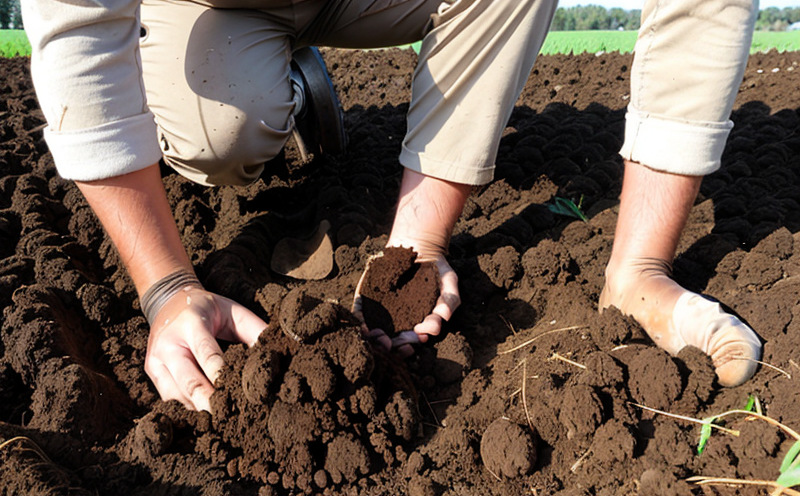Soil Aggregate Size Distribution Testing
The soil aggregate size distribution testing is a fundamental and critical analytical service in agriculture and forestry. Soil aggregates play a pivotal role in the soil's structure, influencing its fertility, water-holding capacity, and overall health. The process involves determining the proportion of different-sized aggregates within a soil sample. This information helps farmers and researchers understand how soil particles are grouped together, which is essential for optimizing crop growth, improving soil quality, and enhancing sustainability.
The testing procedure typically begins with the collection of representative soil samples from various locations in a field or forested area. These samples are then processed to remove organic matter, stones, and other non-soil materials. The cleaned samples are air-dried and sieved into fractions that correspond to different aggregate sizes. After sieving, each size fraction is examined under a microscope to identify the distinct aggregates within it.
The results of this analysis provide detailed insights into the soil's physical structure. Larger aggregates often indicate good soil health, as they promote better water infiltration and root penetration. Smaller aggregates may suggest compaction issues or poor drainage, which can hinder plant growth. This information is invaluable for developing targeted management strategies such as tillage practices, fertilizer application rates, and irrigation schedules.
Understanding the aggregate size distribution also aids in the evaluation of soil's resilience to erosion, particularly in areas prone to heavy rainfall or wind. By knowing the predominant sizes of aggregates, farmers can implement appropriate conservation techniques that enhance soil stability. This service is crucial for quality managers, compliance officers, and R&D engineers working in agricultural and forestry sectors.
One international standard that guides this testing process is ISO 11268-3:2017, which provides detailed procedures for the determination of aggregate size distribution in soils. Compliance with such standards ensures accurate and reliable results, which are essential for making informed decisions about soil management practices.
Why It Matters
The significance of soil aggregate size distribution testing cannot be overstated in the context of agriculture and forestry. Soil aggregates influence a myriad of factors that directly impact crop productivity, water availability, and overall ecosystem health:
Fertilizer Efficiency: Aggregate structure affects how soil particles retain nutrients, thus impacting their availability to plants.
Water Retention: Properly structured aggregates enhance the soil's ability to hold water, which is crucial for plant growth.
Erosion Resistance: Larger, stable aggregates provide better protection against wind and water erosion, preserving topsoil integrity.
Rainfall Management: The distribution of aggregates influences the soil's ability to absorb and retain rainfall, reducing runoff and promoting groundwater recharge.
The results from this testing are vital for quality managers in setting standards and ensuring that agricultural practices meet sustainability goals. Compliance officers rely on these data points when assessing whether operations comply with environmental regulations and best management practices.
For R&D engineers, understanding the aggregate size distribution is essential for developing new soil amendments and tillage systems that enhance soil structure. This knowledge also helps procurement teams source raw materials more efficiently by identifying suppliers who provide soils with optimal aggregate characteristics.
Scope and Methodology
The scope of soil aggregate size distribution testing encompasses the analysis of various physical properties related to soil aggregates. This comprehensive service includes:
Determination of the proportion of different-sized aggregates in a soil sample.
Evaluation of the stability and resilience of soil aggregates under different environmental conditions.
Assessment of the impact of soil management practices on aggregate formation and breakdown.
The methodology for this testing involves several key steps:
Sample Collection: Representative samples are collected from various locations in a field or forested area, ensuring that they reflect the overall composition of the soil.
Preparation: The collected samples undergo thorough cleaning to remove organic matter and other non-soil materials. They are then air-dried and sieved into fractions corresponding to different aggregate sizes.
Microscopy Analysis: Each size fraction is examined under a microscope to identify the distinct aggregates within it. This step requires expertise in recognizing different soil structures, which can vary significantly depending on the region and climate.
The results of this analysis are reported according to international standards such as ISO 11268-3:2017, ensuring consistency and reliability across different testing laboratories. This standardized approach is crucial for quality managers and compliance officers who need accurate data for decision-making processes.
Use Cases and Application Examples
| Use Case | Description |
|---|---|
| Tillage Practice Optimization | Determining the optimal tillage depth based on aggregate size distribution ensures minimal disruption of soil structure. |
| Fertilizer Application Rates | Understanding how different aggregate sizes retain nutrients helps in determining appropriate fertilizer application rates. |
| Irrigation Efficiency | The distribution of aggregates influences the soil's ability to absorb and hold water, impacting irrigation needs. |
| Soil Conservation Strategies | Evaluating aggregate stability helps in developing strategies to reduce erosion and improve soil resilience. |
| Crop Yield Prediction | The health of the soil's physical structure, as determined by aggregate size distribution, can predict crop yields. |
| Environmental Compliance | Data from this testing is essential for ensuring that agricultural operations comply with environmental regulations and best management practices. |
The data derived from soil aggregate size distribution testing has broad applications in both agriculture and forestry. For instance, in agriculture, it helps farmers make informed decisions about tillage depth and fertilizer application rates. In forestry, understanding the soil's physical structure is crucial for managing forested areas sustainably.
This service not only supports quality managers and compliance officers but also plays a vital role in R&D efforts aimed at improving agricultural practices and enhancing soil health. By providing precise data on aggregate size distribution, this testing ensures that environmental regulations are met while promoting sustainable farming and forestry practices.





